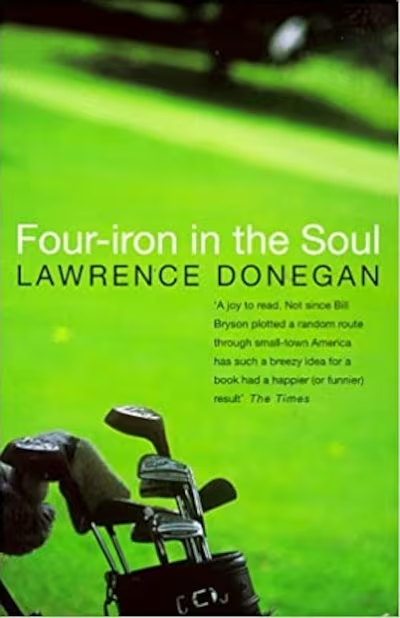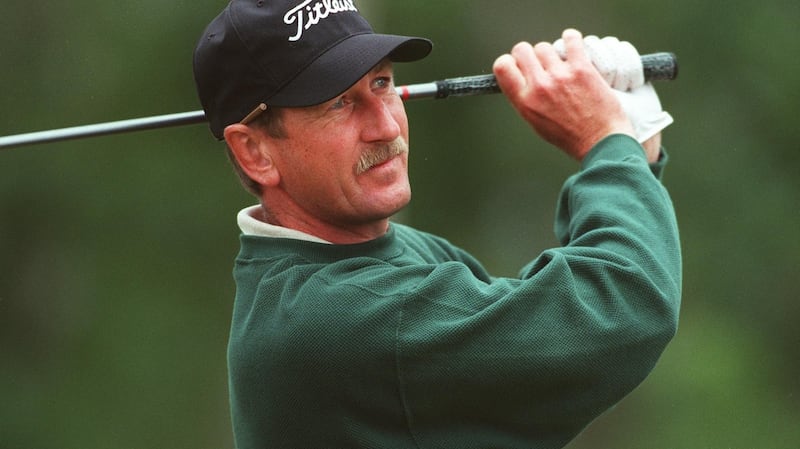It wouldn’t be stretching things to say that Lawrence Donegan ventured along the road less travelled before coming up with the idea for Four-iron in the Soul, his best-selling book – into a 40th print run – which brilliantly captured the trials and tribulations of a professional golfer on the PGA European Tour, journeyman Ross Drummond being the central character of it all.
To get to how Donegan’s account of that 1996 season worked so well and earned a longevity in book sales, it is worth recounting that the writer had lived a life before branching out into being a wordsmith. While studying at the University of Glasgow, he joined the Bluebells – as a guitarist – who would have a number one hit with Young at Heart which later featured on a Volkswagen advert, and subsequently left them to join another band, Lloyd Cole and the Commotions.
“I was touring America at 20 years of age or whatever . . . and, with the Commotions, toured the world three times,” recalled Donegan. He has a cupboard full of golden discs and, to this day, royalties for the Commotions’ Rattlesnakes hit album as a reminder of those years he refers to when living the “rock’n’roll ways”.

Donegan moved from strumming chords on a bass guitar to writing after the Commotions broke up. The route involved journalism school – where Conservative politician Michael Gove was a classmate – and on into a new working life and stints with the Northern Echo (with Tony Blair as the local MP), the Scotsman and the Guardian, where the seeds for Four-iron in the Soul were planted, if almost accidentally.
When working on the newsdesk of the Guardian, Donegan read a book by Michael Bamberger – On To Linksland – which was a mystical search to find golf’s soul on the links of Scotland.
However, the start of the book involved a spell of Bamberger caddying for an American golfer Peter Teravainen on the European Tour. Donegan ventured over to the sports desk, pitched his idea for a feature, where he would spend a week caddying for a player. The newspaper’s golf correspondent Dai Davies put him in touch Ross Drummond who agreed to Donegan carrying his bag because he’d be working for free. Donegan caddied for the Scot in the Air France Open, the player finished 13th, and the feature appeared. End of? Not quite.
“You should write a book,” someone said to him.
Bidding war
“My mate’s an agent,” said someone on the desk. The agent? Jonny Geller. “He’s now one of the most famous in the world but he was just a kid then, so I went along with a sample chapter. So he calls me about three weeks later. ‘You’re not going to believe this, we have a bidding war, four publishers’. It was kind of scary.”
The seed grew, with Penguin winning the publishing rights. The newspaper gave him leave of absence to go off and write his book . . . and off he went, having come to a deal with Drummond to caddie but without wanting the traditional percentage of any winnings.
“Ross wasn’t a compelling figure in any way, he was a jobbing golf professional but what I liked about that was the dignity of it, he was a very dignified guy, the dignity of labour, that appealed to me rather going out there with some superstar or some deadbeat guy who has not got a chance.

“Ross was perfect, right in the middle. He was like an everyman figure, in the European Tour, there was a certain dignity about him, and just a nice guy. And for him, I think he looked upon it as something, like, ‘my career is just going along, need something to put a rocket in my backside’; in a way I was using him, but he was using me to put some extra rocket fuel in the Morris Minor.”
The trouble with a living book is that circumstances determine the narrative and, just over two months into the 1996 season, Donegan wondered where it was going.
Drummond was struggling to make cuts, week after week. In diverting into the social consciences of those places he visited, racial tensions in post-Mandela South Africa among them, Donegan managed to cross over in his writing but he needed his man to start delivering on the course. “It was crap after crap, bad performances all the way through. I was slightly worried at that point, it just can’t be a litany of failure . . . it was not working out well and I’m thinking, ‘I am going to get the sack here, this is terrible’.”
Then, the pair went to the Benson & Hedges International at The Oxfordshire in England. “It was a horrible week, pissing rain. I met him on the Thursday and he says: ‘I picked up this tape at the garage’. It’s a self-help tape, one of those psychology tapes by a guy called Anthony Robbins. It was called Awaken the Giant Within. And, I’m like, ‘at last, this is gold’ because he has reached the desperation stage, buying tapes in a garage on the motorway.”
That week, Drummond didn’t just make the cut. He contended, playing in the same group as Nick Faldo in the final round. “I still have the tape somewhere, I’m wearing red waterproofs and we are walking down there and we are on TV and Peter Alliss is commentating about us. Well, it’s a big moment here for Drummond, he is tied for the lead and Nick Faldo has just won a Masters, and I’m like Faldo? And he’s going yes I beat him Scottish boys against English boys, I beat him. It is this [psychology] tape.”
Drummond didn’t win, Stephen Ames did. But Drummond’s tied-fourth finish changed the book’s narrative.
“That was the week the book took off, the whole thing. In terms of writing it, I wasn’t worried after that . . . the next incident in terms of the structure of the book was we’d always agreed I would take a week off in the middle of the season and go to Donegal to write, because the book had to be delivered on the final whistle.”
Donegal hideaway
For the Slaley Hall tournament in the north of England, Drummond picked up a local caddie and Donegan retreated to the Donegal hideaway. What Donegan hadn’t anticipated was that Drummond – without him – would contend all the way down the stretch until Retief Goosen managed to close the deal.
“Ross has never won a tournament in his whole career, ever, and on that Sunday I swear to God I was vomiting. I watched the whole tournament on Teletext or Ceefax or whatever it was. I had the radio on and he was contending for most of the day and I was delighted he lost. It would have been a disaster, I don’t know how I would manage to write around that.
“The narrative had been woven by then, I caddied for a journeyman golf professional, shite, shite, shite, shite, amazing. I have taken this guy from 438th in the world, by the middle of the season he was 135. Clearly a coincidence, but I was on his bag when that happened.”
The pair didn’t last the whole season. Their relationship finished at the British Masters, where he told the player there was no room in the bag when Drummond took off his sweater. “There was enough room for a Chesterfield settee,” wrote Donegan.
“We never fell out. I was exhausted, he was fed up with me probably . . . we just agreed, it has been eight months, that’s probably long enough,” he recalled.
Although there was an offer to go with another player, Donegan decided to go off, finish the manuscript. It was delivered to the publisher within a month of the season ending.
“The first book is the easiest you will ever write, because you are not terrified. You have got no blockages, just a process you are going through, one chapter after another. It is a bit like making your first album. There is no pressure, you just do it. With Rattlesnakes, 40 years later we still get royalties but we were just kids.
“It was the same writing Four-iron in the Soul. I was lucky the actual events fell into three distinct acts. You had the mundane, then you had the plot point at the end of the first act, which was The Oxfordshire, which took you into the second act, this guy is actually good, and then you get to the third act and it is going to go one way or another, they are either going to triumph or going to fall out. I was very lucky.
“It appealed because it was a good idea and it was really well executed and it slightly crosses over. There was a very important review in the life of the book. Bill Bryson was the biggest name in publishing at that time and The Times of London said if Bryson had written a golf book this would have been it. So, the reviews were just stunning and it was in all the book of the year lists and it crossed over.
“It is still in print. It sold in the hundreds of thousands and still sells. The first album you just do it, you don’t think about it. With the book, I just stood up there and I slashed at the ball and lo and behold it all went off in the air. It gets harder after that, as I quickly discovered.
“For that one magical year it all came together. I was lucky with the character with Ross, because he was an extremely likeable character, and lucky with the way event turned out,” said Donegan, whose latest project is a novel about Shergar which he is self-publishing.










